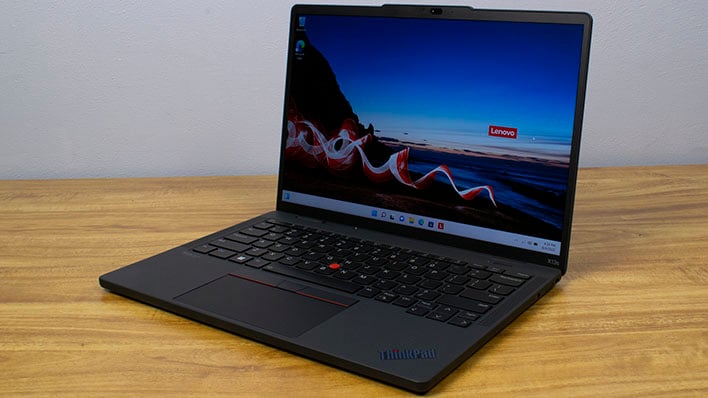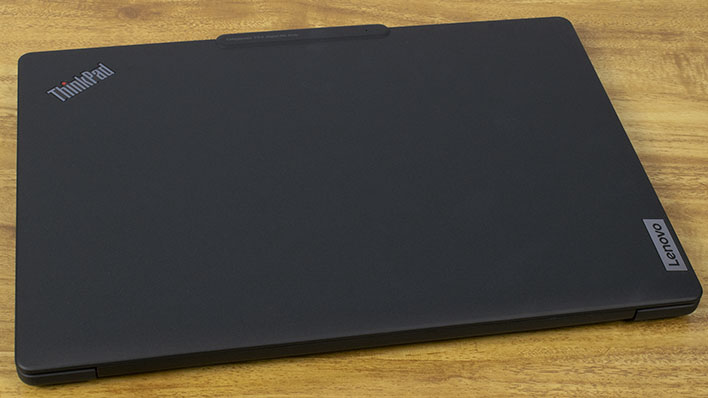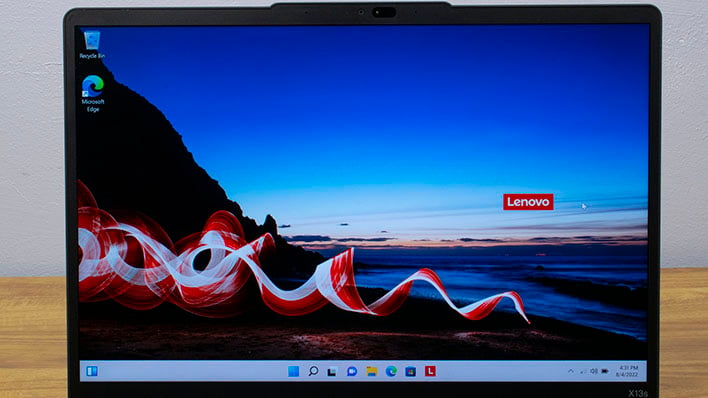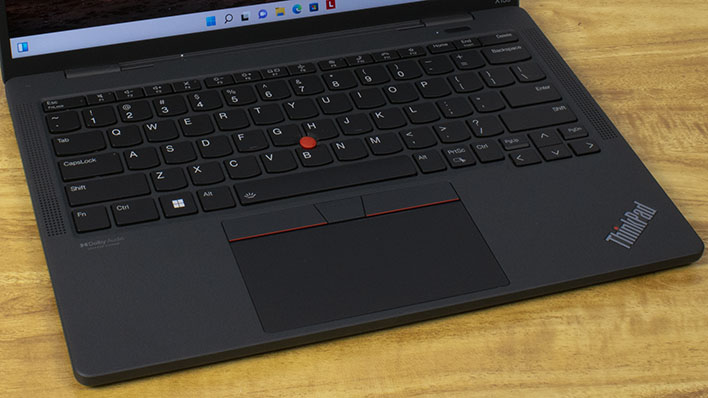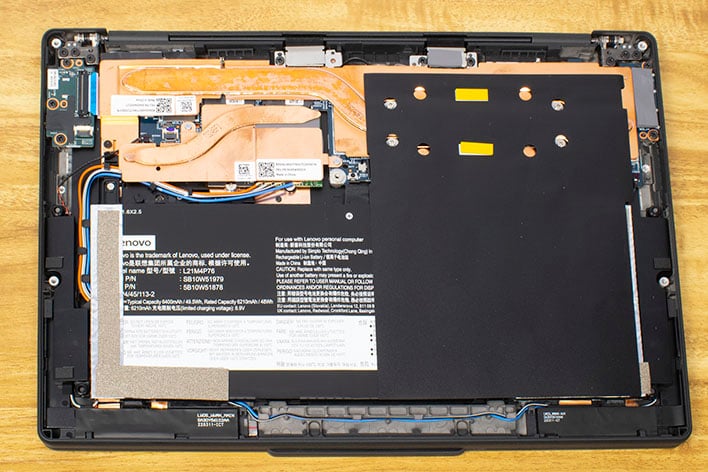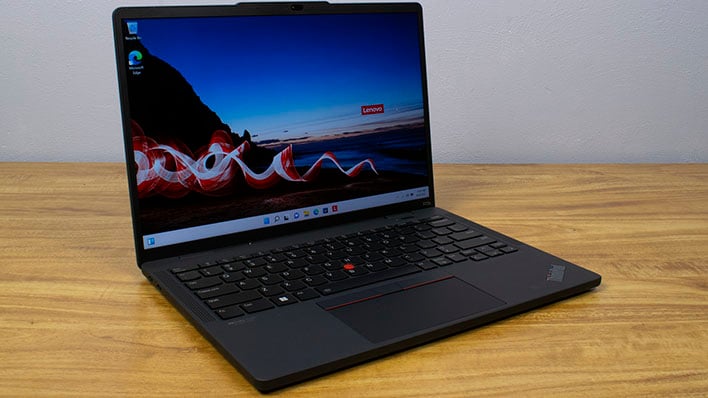Lenovo ThinkPad X13s Gen 1 Review: Big Snapdragon Performance Gains
ThinkPad X13s Gen 1 - Lenovo's New Snapdragon-Powered Machine Impresses With Markedly Improved Performance And The Same Great Battery Life
| Lenovo ThinkPad X13s - Starting MSRP: $1085 Lenovo's new Snapdragon 8cx Gen 3 notebook brings a big performance uplift over previous models without sacrificing its incredible battery life
|
|||

|

 |
||
Arm64-based Windows laptops have traditionally been somewhat of a hard sell. Sure, the aptly-named Always Connected PCs have all-day battery life and an always-on internet connection, but the performance of the previous-generation Snapdragon 8cx (or Microsoft's SQ1 in the Surface Pro X) couldn't keep up with its x86 brethren. The lack of native Arm64 apps compounded the issue due to the need to rely on an x86 compatibility layer. Fortunately, Qualcomm has put a lot of that in the rear view mirror: the Snapdragon 8cx Gen 3 -- and as a result, Lenovo's ThinkPad X13s Gen 1 we'll be showing you here -- is a huge step up over the last iteration, providing the performance boost the platform sorely needed. However, before we get to that, let's meet this super lightweight notebook.
Lenovo ThinkPad X13s Gen 1 Specs and Features
| Processor | Qualcomm Snapdragon 8cx Gen 3 (8 cores Arm64, 4x Cortex X1, 4x Cortex A78) |
| Display | 13.3-inch 1920x1200 LED backlit anti-glare display, max 300 nits |
| Graphics | Qualcomm Adreno 690 integrated graphics |
| Storage | 512 GB M.2 PCI Express NVMe SSD (user replaceable) |
| Memory | 16 GB LPDDR4x 4,266 effective MHz (soldered) |
| Audio | Stereo Speakers with Dolby Atmos |
| Camera | 5 Megapixel HD Webcam with 1080p video |
| Networking | Qualcomm 802.11ax Wi-Fi 6E Bluetooth 5.1 Qualcomm X55 sub-6 and mmWave 5G modem |
| Ports: Right | 1x 5G SIM slot 1x Four-pole Headset |
| Ports: Left | 2x USB Type-C (USB 3.1 Gen 1 + DisplayPort Alternate Mode) |
| Ports: Rear | none |
| Keyboard | ThinkPad tenkeyless keyboard with integrated TrackPoint |
| Touchpad | Single-piece seamless touchpad with two discrete buttons |
| Battery | 49.5 Watt-hour, supports Rapid Charge |
| Weight | 2.35 lbs (1.06 kg) |
| Dimensions | 11.76 x 8.13 x 0.53" (298 x 206 x 13.4 millimeters) |
| Warranty | 1 year limited hardware warranty |
| Operating System | Windows 10 Pro |
| Price | Starts at $1,085 from Lenovo ($1,301 as tested) |
The ThinkPad X13s is built around Qualcomm's latest high performance PC chipset, the Snapdragon 8cx Gen 3. This SoC has a maximum single-core clock speed of 3 GHz with a quartet of Arm Cortex X1 cores and four Cortex A78 cores that add some multi-threaded horsepower to handle background tasks. When Qualcomm announced the chip at its Tech Summit in January this year, it promised upwards of an 85% performance boost, though it didn't specify if that was for single-threaded or multi-threaded tasks, or both. Graphics rendering is handled by Qualcomm's Adreno 690 integrated GPU, and the company also boasts a 60% GPU performance increase there, which we should be able to test shortly.
There's also 16 GB of LPDDR4X-4266 of memory soldered to the motherboard, along with a 512 GB or 1 TB solid-state drive. The SSD comes in the slightly unusual M.2 2242 size, which is 42 millimeters long compared to the more common 80 mm of most aftermarket SSDs. At least it's a standard type and replaceable, unlike what you'll find in a certain fruity Arm64 laptop vendor's notebooks. We also found that it's pretty easy to get inside this machine by popping off the bottom cover. For network connectivity, there's 802.11ax Wi-Fi 6E, Bluetooth 5.1, and an optional Qualcomm X55 modem with mmWave 5G connectivity. There's also a 49.5 Wh battery to keep the juices flowing for up to 28 hours, according to Lenovo's measurements.
On the outside, the ThinkPad X13s Gen 1 is very much like any other ThinkPad. The build quality is quite sturdy, made of a black soft-touch polycarbonate shell wrapped around an aluminum and magnesium frame. There's just a hint of flex in spots, but it still feels pretty solid and premium. Lenovo touts an eco-friendly manufacturing process, as the X13s's frame is made from 90% recycled materials, and the system's speaker frame, AC adapter, and battery all contain post-consumer materials. Lenovo has also moved to an all-recycled cardboard packaging without any plastic wrapping around the exterior of the box.
Using the ThinkPad X13s feels like any other ThinkPad, too, which is a very good thing. The machine's16:10 IPS display has a resolution of 1,920 x 1,200. An anti-glare coating comes standard, though touch functionality is an option. Either way, the display has a maximum brightness of just 300 nits, which is a bit on the low side for a laptop and not really readable outdoors in sunny conditions. Indoors, 300 nits is fine, and the colors it produces are well-saturated and accurate, with good contrast and decent viewing angles.
Right above the display sits a 5-megapixel webcam with a privacy shutter. A full-HD camera with infrared Windows Hello compatibility is optional, and also optional is the FHD version with a MIPI interface for computer vision tasks. No matter which version you select, the camera captures 1080p video which we found to look pretty nice compared to the 720p that's still found on far too many notebooks these days (we're looking at you, Dell). A noise-canceling microphone array makes sure that callers can hear our voices and background noise is cut way back. The speakers have Dolby Audio certification, but don't really sound much different than most laptop speakers, with enough vocal clarity and decent highs, but little bass response to speak of.
The keyboard is nothing surprising, again, in a good way. We always love Lenovo's ThinkPad keyboards for their responsiveness, spill-resistant protection, shaped key caps and good backlighting. Typing is very comfortable here, and we never had any issues with dropped keystrokes or ghosted input. The backlight is handy when typing in the dark too, of course.
The trackpad and typical Lenovo TrackPoint are both present as well. The trackpad is 110 millimeters wide and 40 millimeters tall, which is big enough to use without pushing the keyboard back uncomfortably far. The trackpad also responds to taps, but there are discrete buttons above it which are convenient for both trackpad and TrackPoint users. Inputs on a laptop are extremely important and Lenovo did a nice job as always.
External connectivity is fairly limited, as there's just a pair of USB-C ports with USB 3.2 Gen 2 (10 Gbps) bandwidth and no hint of Thunderbolt. One of those ports will be populated with the included 65-Watt charger when in use, and should also work with any number of USB-C power delivery adapters or docks, too. There's also a four-pole combination headset/microphone port and a SIM slot for the models that come equipped with the Qualcomm 5G modem.
Tearing Down the ThinkPad X13s Gen 1
When we tear into the ThinkPad X13s, we can see that it's got a totally fanless design with just a large copper cooler to dissipate heat. We had no problems with accumulated heat, however. We can also see the heat pipe goes over the M.2 slot, which can be seen up close in an upgrade video on Lenovo's website. The RAM is soldered, but even the sub-$1,100 base model comes with 16 GB of LPDDR4x-4266 memory, so we don't believe the system will be overly constrained. Finally, at the bottom, we can see the 49.5 Wh battery.
Because of the fanless design, the ThinkPad X13s Gen 1 is absolutely silent, which is a pretty fantastic feature in a lot of settings. I'm personally spoiled when it comes to quiet laptops since my daily driver is also totally silent, and this did not upset the apple cart in the least. Yet despite the fanless design, this machine barely even feels warm on the bottom under a heavy load. Qualcomm clearly put power consumption and battery life at the forefront of its design goals for the Snapdragon 8cx Gen 3, and Lenovo made good use of this by going premium and fanless here.
ThinkPad X13s Gen 1: Snapdragon Power Unleashed
A funny thing has happened since the last time we looked at Snapdragon 8cx performance. Actually, several funny things: Apple released its own Arm-powered notebooks, Windows 11 on Arm gained x86-64 emulation to bring a big upgrade in compatibility, and Google has remained steadfast in its refusal to support Arm64 on any platform beyond its own Chrome OS and Apple's macOS. Sure, Microsoft has ported its Chromium-based Edge browser, but Google simply needs to get off the dime for Chrome fans.But enough about third-party software issues; let's see what this thing is capable of. First up is BrowserBench Speedometer 2, the rendering test that works out a huge number of JavaScript frameworks in a simulated yet crucial real-world scenario.
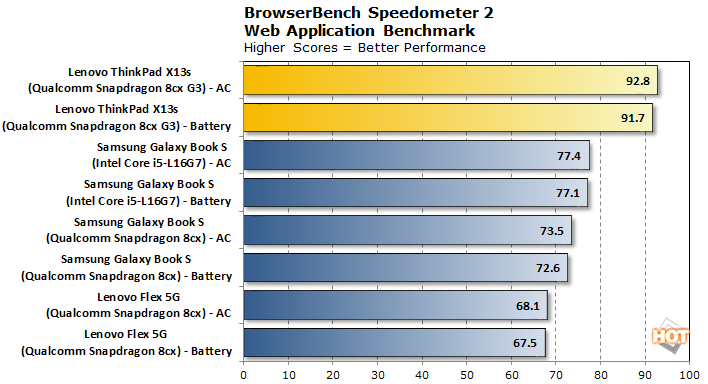
Speedometer gets the ThinkPad X13s off to a good start, at least in comparison to the other Arm64 notebooks in our test group. The 19-point jump compared to the Snapdragon 8cx Gen1 version of the Galaxy Book S represents a 26.3% increase in performance in what is a pretty common use case. Browsing the web is the most basic, mandatory task these days and the ThinkPad X13s and its Gen 3 Snapdragon do a much improved job compared to previous generations. It's even a nice boost over the Core i5-L16G7 version, which is Intel's first attempt at a hybrid architecture.
While the desire to click the link to our Lenovo ThinkPad X1 Carbon review and note that just about all the x86 machines are nearly 200% faster than the ThinkPad X13s may be strong, we urge you to hang tight for a moment. We think you'll understand soon.
Next up is the old stand-by synthetic Geekbench 5 test, which flexes both single-threaded and multi-threaded performance.
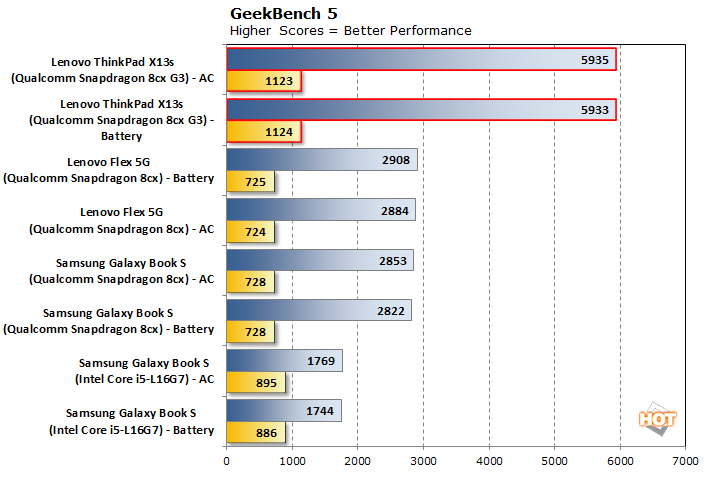
Whoa. First of all, the ThinkPad X13s is 55% faster than the Snapdragon 8cx Gen 1 version of the Lenovo Flex 5G in single threaded workloads. That's wonderful in and of itself, but the multi-threaded score is also 104% faster than before. Right about now we were pretty confident that these tests were at least in part the result of improved or more optimized operating system, so we re-ran these tests on a clean and freshly updated Samsung Galaxy Book S. And yet, it barely budged and the ThinkPad X13s is 55% and 104% faster. The multi-threaded score is at least in part due to the much better efficiency cores, but it's impossible to deny that Qualcomm made some big leaps in performance with single-threaded applications.
And again, while it may be tempting to flip over to the Mac Studio review and note that the $700 Arm64-based Mac mini still has large leads in 1T and multi-threaded scores, once again, we're going to ask you to resist that temptation for a moment. There's something else you need to see.
Let's move on to PCMark 10. Rather than run the full PCMark test suite, we focused on Microsoft Office application performance in the Applications test.

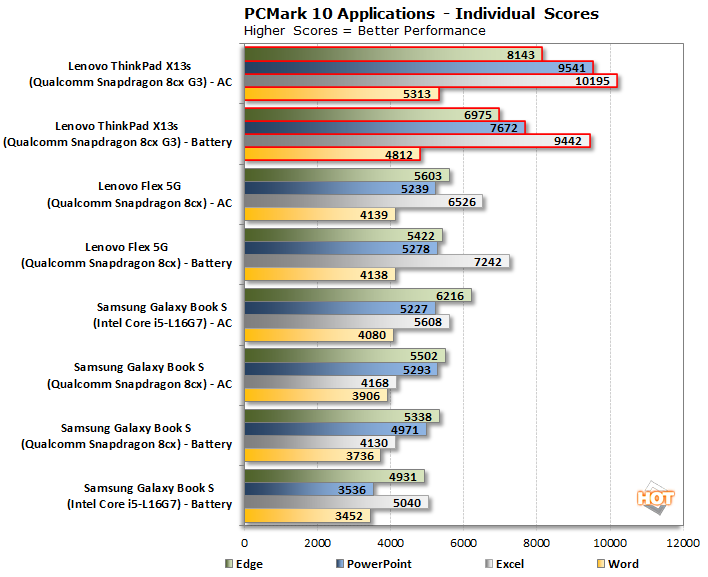
This is the first really sustained test, and as a result it's the first time we see the ThinkPad X13s bleed off some performance while away from a wall outlet. That's not a bad thing; x86 laptops have been doing it for years, and as you can see it's still miles faster than the first-gen Snapdragon 8cx.
In late 2021, Microsoft released Arm64-native versions of the MS Office suite as UWP applications, and UL recommends using them. Unfortunately for the older laptops, specifically the Galaxy Book S, it didn't really seem to make a difference. That means the outright win for the ThinkPad X13s is again due to the architectural enhancements of the latest Snapdragon. Isn't progress grand? It's important to note that the increases in Browserbench performance are reflected here in the Edge subtest score which, even on battery, is a wide margin ahead of the previous generation.
Next up we're going to move on to 3DMark Night Raid and Wild Life Extreme Unlimited. These tests are both Arm-native. Unfortunately it's not possible for us to re-run this test on the Lenovo Flex 5G, but we ran it on both Galaxy Book S notebooks.
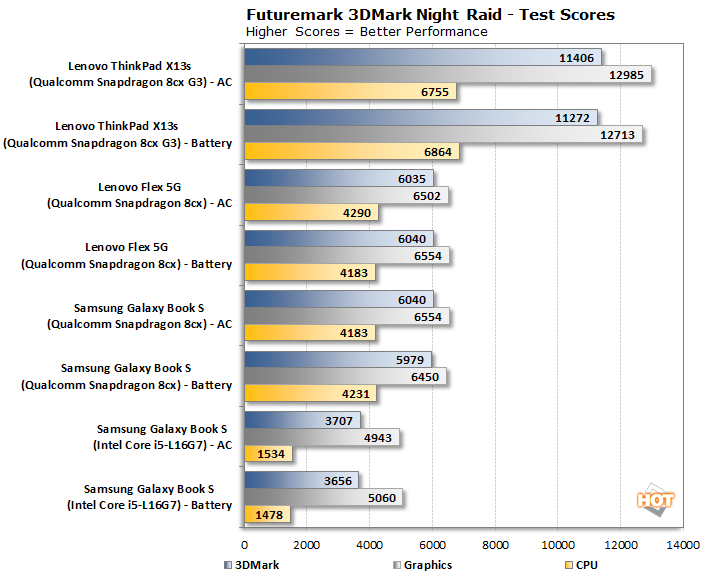
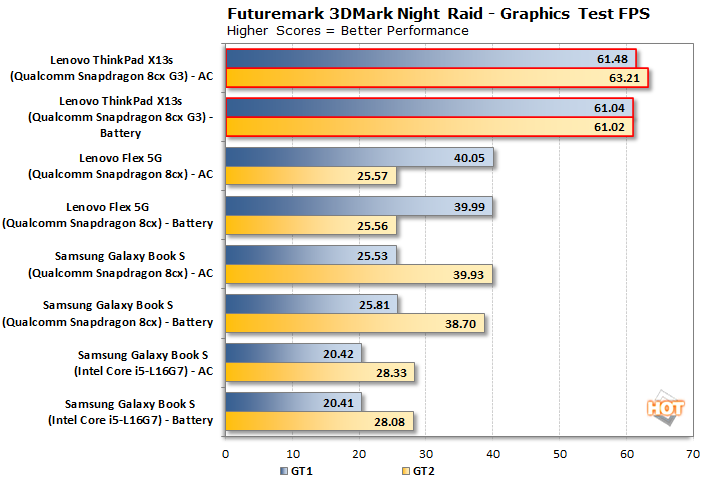
Night Raid shows that the Adreno 690 graphics in the ThinkPad X13s are just like the CPU -- much, much faster than the previous gen platform. CPU scores were around 55-60% faster than before while the graphics scores were close to twice as fast. This is a big step up, obviously, and something that Qualcomm should be commended for achieving. There aren't too many Arm64-native games yet on Windows, but if they start to come, we think the ThinkPad X13s will be up to the task.
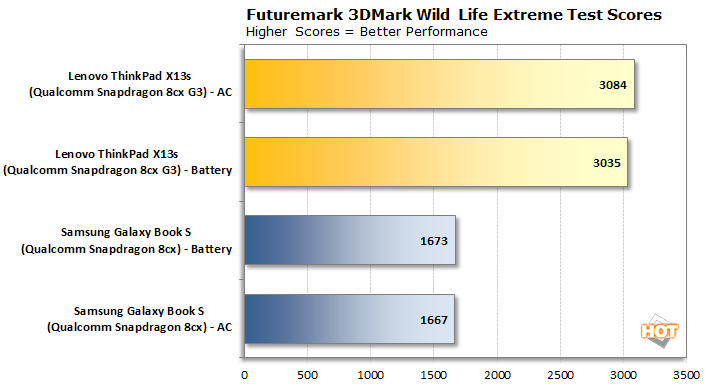
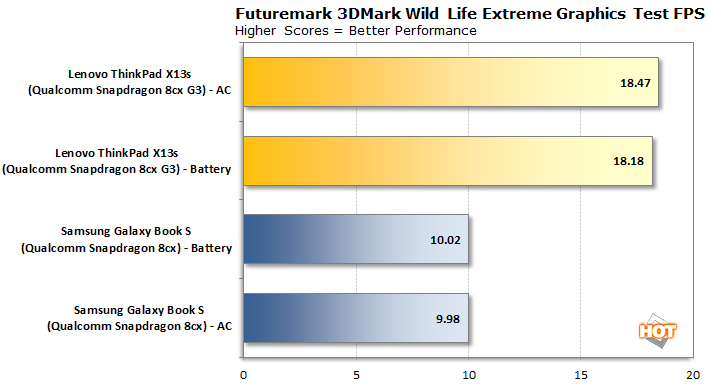
We don't have nearly the test results for Wild Life Extreme Unlimited just yet, but we can get a pretty clear picture of the performance versus other the 1st gen Snapdragon 8cx. It's a big jump, just like before -- graphics performance is up over 90 percent here, which is a night and day difference.
There's one last test to look at, and that's battery life. To test this, we used the Arm64 beta of VLC to run our normal video loop test. The display was set as close to 115 lux as possible and it just ran the video repeatedly in full-screen mode until the battery was exhausted.
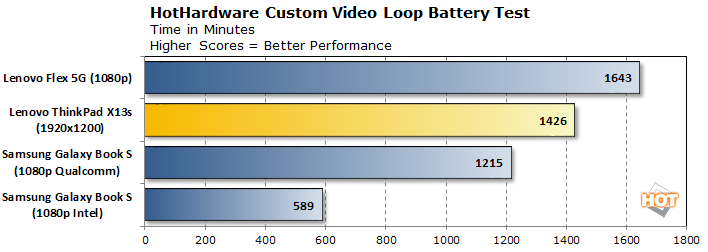
There you have it. Just 14 minutes short of 24 hours. The huge uptick in performance for Lenovo's machine and Snapdragon 8cx Gen 3 did not come at the cost of battery life. The same 50 Wh battery you find in most notebooks is employed here, and the result speaks for itself. We urge you to resist comparing the ThinkPad X13s to Intel notebooks like the Dell XPS 13 Plus. But now if you want to look at those results, the ThinkPad X13s lasted almost three times as long. It's also pretty rosy compared to other Arm64 laptops. not only did it best the Galaxy Book S, but it also tops the 14-inch MacBook Pro with the M1 Pro SoC by nearly 900 minutes -- the ThinkPad lasted way more than twice as long. Qualcomm and Intel -- and indeed, Qualcomm and Apple -- have different priorities in their processor designs. Qualcomm has clearly steered into "good enough" performance and amazing battery life, where Intel's 12th-gen CPUs lean in the other direction. Apple kind of split the difference in terms of battery life. If you're on a multi-day trip and need your PC to always have a charge, the ThinkPad X13s is a real winner.
Lenovo ThinkPad X13s Performance Wrap-Up And Review Conclusion
Overall, performance of this machine is greatly enhanced over previous-gen Snapdragon-based systems, including the Surface Pro X built with Microsoft's semi-custom version of Qualcomm's first gen 8cx silicon. Across the board, multi-threaded performance is way up, and more importantly, single-threaded performance took a big step forward too. It's a little unfortunate that if we flip back to the Mac Studio review to see that even the lowly 2020 Mac mini is still much faster from a pure CPU standpoint, but the fact remains that Qualcomm's CPUs are untouched on the Windows side when it comes to efficiency and battery life. So, if you need Windows software, Apple's hardware is just not a consideration, obviously.The trouble will come when it's time to run an app that isn't Arm64-native. Fortunately, Microsoft has finally seen fit to port Office and OneDrive to Windows on Arm, as both products were released in late 2021. However, plenty of other apps haven't made the jump quite yet. Google Chrome or Adobe's content creation tools are both x86-only on Windows. Chrome is the most-used browser on the planet with native Arm builds on Android, ChromeOS, and macOS, but not Windows, while Adobe has had M1-native Mac apps for over a year.
The list goes on, and it's a pretty sad state three years on from the first serious Windows PCs running Arm processors. None of that is Lenovo's fault, of course; Windows on Arm needs a serious developer-focused push from Microsoft. We happen to test with apps that already have native ports, but the rest of the world needs to get on board stat.
The ThinkPad X13s' performance has markedly improved and its a very viable platform overall. Unlike the Gen 2 version of the Snapdragon 8cx, the latest iteration is significantly faster than its predecessor. Web browsing is snappier, office productivity is faster, and graphics performance is greatly enhanced. The best part is that none of this comes at the expense of battery life, which is still as outstanding as it has been on all the Snapdragon 8cx versions. Qualcomm targeted battery life in a big way here, yet progress in technology allowed a pretty big bump in performance to go along with it. All of that comes wrapped in a positively featherweight, fanless design that's sleek and highly portable.
Pricing is always critical, and thankfully the ThinkPad X13s is pretty reasonably priced. The base model has 8 GB of LPDDR4x and a 512 GB SSD with a 1920x1200 non-touch display and no 5G modem for $1,085 direct from Lenovo. Our review unit with 16 GB of LPDDR4x and the same 512 GB of storage, but with a 5G modem runs $1,301. In that same price range is a Core i5 version of the XPS 13 Plus with just 8 GB of memory and a 512 GB SSD, but no 5G modem, or a similarly equipped M1 MacBook Air, which at least has a higher-resolution 2560 x 1200 display. Both of those competing laptops will not last as long on battery, and both need to be tethered to a phone for cellular internet connectivity. The performance sacrifice seems reasonable for the price, if connectivity and untethered endurance are high priorities for you.
Would we pick the ThinkPad X13s -- or more importantly, should you? That's really up to the use case. If you require maximum performance on the go, an x86 laptop might be the best option. However, if longevity is king, "good enough" performance will do, and if the desired software loadout has Arm64 versions available, the ThinkPad X13s might just be the laptop for you.


